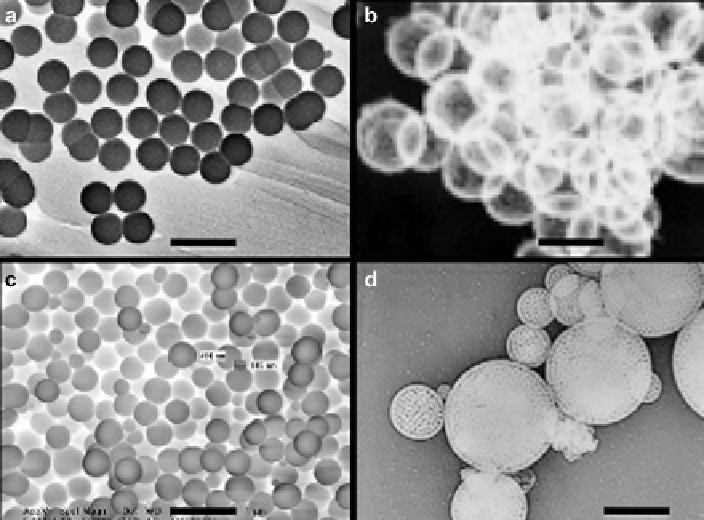Biomedical Engineering Reference
In-Depth Information
Fig. 1
Silica nanoparticles : (
a
) SEM of plain silica nanoparticles (scale bar = 2 mm) (Reprinted
from (Chang et al.
2005
), Copyright (2005), with permission from Elsevier), (
b
) TEM of liposils
(scale bar = 200 nm) (Reprinted from (Bégu et al.
2007
), Copyright (2007), with permission from
Elsevier), (
c
) SEM of PLLA@silica homogeneous particles (scale bar = 1 mm) (From Zalzberg and
Avnir
2008
. Copyright Springer Science + Business Media, LLC 2008), (
d
) TEM of mesoporous
particles (scale bar = 300 nm)
et al.
2009
). In particular, it is important that some water is present in the reaction
media to allow the hydrolysis of the silane before it can condense on the silica
surface. On the other hand, there is a reasonable probability for self-condensation (i.e.
organosilanes react with each other rather than with the silanol groups on the surface)
resulting in the grafting of a silane chain rather than a one-to-one grafting. When the
desired function is not available, it is possible to perform a coupling reaction on the
initial silane or on the pre-grafted function. Many considerations should be taken into
account when selecting the most convenient approach. In particular, the first approach
must be performed in water-free conditions that can be a very drastic limit. In prin-
ciple, silica nanoparticles can also be coated by polymers by simple adsorption. To
improve the stability of the coating, the particle surface may be pre-grafted. However,
the most efficient method relies on the grafting of a monomer followed by controlled
polymerization (Radhakrishnan et al.
2006
). To complete this overview, it is worth
noting that it was possible to coat silica particles with lipid bilayers exhibiting high
stability (Van Shooneveld et al.
2008
).
The above-described approaches lead to core-shell structures where the organic
functions are localized on the particle surface. The mirror situation, where a silica
shell is surrounding an organic or bio-organic core, was also described (Zou et al.
2008
).

Search WWH ::

Custom Search